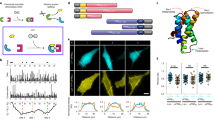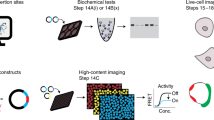Abstract
Using new chemically inducible dimerization probes, we generated a system to rapidly target proteins to individual intracellular organelles. Using this system, we activated Ras GTPase at distinct intracellular locations and induced tethering of membranes from two organelles, endoplasmic reticulum and mitochondria. Innovative techniques to rapidly perturb molecular activities and organelle-organelle communications at precise locations and timing will provide powerful strategies to dissect spatiotemporally complex biological processes.
This is a preview of subscription content, access via your institution
Access options
Subscribe to this journal
Receive 12 print issues and online access
$259.00 per year
only $21.58 per issue
Buy this article
- Purchase on Springer Link
- Instant access to full article PDF
Prices may be subject to local taxes which are calculated during checkout


Similar content being viewed by others
References
Schreiber, S., Kapoor, T.M. & Wess, G. Chemical Biology: From Small Molecules to Systems Biology and Drug Design (Wiley-VCH, 2007).
Inoue, T., Heo, W.D., Grimley, J.S., Wandless, T.J. & Meyer, T. Nat. Methods 2, 415–418 (2005).
Suh, B.C., Inoue, T., Meyer, T. & Hille, B. Science 314, 1454–1457 (2006).
Fili, N., Calleja, V., Woscholski, R., Parker, P.J. & Larijani, B. Proc. Natl. Acad. Sci. USA 103, 15473–15478 (2006).
Stankunas, K. et al. ChemBioChem 8, 1162–1169 (2007).
Stankunas, K. et al. Mol. Cell 12, 1615–1624 (2003).
Mor, A. & Philips, M.R. Annu. Rev. Immunol. 24, 771–800 (2006).
Marshall, C.J. Cell 80, 179–185 (1995).
Karpova, A.Y., Tervo, D.G., Gray, N.W. & Svoboda, K. Neuron 48, 727–735 (2005).
Soltys, B.J. & Gupta, R.S. Biochem. Cell Biol. 70, 1174–1186 (1992).
Pizzo, P. & Pozzan, T. Trends Cell Biol. 17, 511–517 (2007).
Hayashi, T., Rizzuto, R., Hajnoczky, G. & Su, T.P. Trends Cell Biol. 19, 81–88 (2009).
de Brito, O.M. & Scorrano, L. Nature 456, 605–610 (2008).
Csordas, G. et al. J. Cell Biol. 174, 915–921 (2006).
Varnai, P., Toth, B., Toth, D.J., Hunyady, L. & Balla, T. J. Biol. Chem. 282, 29678–29690 (2007).
Perkins, E.M. & McCaffery, J.M. Methods Mol. Biol. 372, 467–483 (2007).
Kobayashi, T. & Arakawa, Y. J. Cell Biol. 113, 235–244 (1991).
Acknowledgements
We thank B. Wattenberg (University of Louisville) for Cb5/MoA plasmids; N. Ishihara (Toyko Medical and Dental University) for Tom20 plasmid; C. Machamer (Johns Hopkins University) for Giantin plasmid; W.D. Heo (Korea Advanced Institute of Science and Technology) for RasGRF plasmid; F. Tsuruta (University of Tsukuba) for LAMP plasmid; M. Fivaz (Duke-National University of Singapore Graduate Medical School Singapore) YFP-RBD plasmid; and T. Wandless (Stanford University) for providing rapamycin analogs (iRap, synthetic ligand of FKBP, FK506M); F. Fernandez, M. Fivaz, M. Meffert, J. Zhang, V. Sample, D. Montell, M. Caterina, P. Devreotes, A. Ewald and D. Robinson for critical review of the manuscript; R. Pagano for helpful comments on PS assays; and Z. Wei, W. Wong, K. Venkatachalam and J. Cordon for a technical assistance with western blot analyses. Supported in part by US National Institutes of Health (MH084691 to T.I., NCRR1S10RR023454-01 to J.M.M.). T.K. and T.U. are recipients of a fellowship from Japanese Society for the Promotion of Science.
Author information
Authors and Affiliations
Contributions
T.K., I.K., T.U., L.C.V. and T.I. designed and conducted molecular/cellular biology experiments with following data analysis. J.M.M. took and analyzed TEM images. T.I. conceived and supervised the project, and wrote the paper.
Corresponding author
Ethics declarations
Competing interests
The authors declare no competing financial interests.
Supplementary information
Supplementary Text and Figures
Supplementary Figures 1–9, Supplementary Table 1 (PDF 2476 kb)
Supplementary Video 1
Time-lapse confocal fluorescence images of HeLa cells showing translocation of cytoplasmic proteins to the Golgi upon iRap addition. (AVI 9732 kb)
Supplementary Video 2
Time-lapse confocal fluorescence images of HeLa cells showing translocation of cytoplasmic proteins to the ER upon iRap addition. (AVI 5997 kb)
Supplementary Video 3
Time-lapse confocal fluorescence images of HeLa cells showing translocation of cytoplasmic proteins to the lysosomes upon iRap addition. (AVI 8229 kb)
Supplementary Video 4
Time-lapse confocal fluorescence images of HeLa cells showing translocation of cytoplasmic proteins to the mitochondria upon iRap addition. (AVI 25185 kb)
Supplementary Video 5
Time-lapse confocal fluorescence images of HeLa cells showing ER-mitochondria tethering upon iRap addition. This movie corresponds to ER. (AVI 5480 kb)
Supplementary Video 6
Time-lapse confocal fluorescence images of HeLa cells showing ER-mitochondria tethering upon iRap addition. This movie corresponds to mitochondria. (AVI 5480 kb)
Rights and permissions
About this article
Cite this article
Komatsu, T., Kukelyansky, I., McCaffery, J. et al. Organelle-specific, rapid induction of molecular activities and membrane tethering. Nat Methods 7, 206–208 (2010). https://doi.org/10.1038/nmeth.1428
Received:
Accepted:
Published:
Issue Date:
DOI: https://doi.org/10.1038/nmeth.1428
This article is cited by
-
Defunctionalizing intracellular organelles such as mitochondria and peroxisomes with engineered phospholipase A/acyltransferases
Nature Communications (2022)
-
Rational design and implementation of a chemically inducible heterotrimerization system
Nature Methods (2020)
-
The light-sensitive dimerizer zapalog reveals distinct modes of immobilization for axonal mitochondria
Nature Cell Biology (2019)
-
Integrating chemical and mechanical signals through dynamic coupling between cellular protrusions and pulsed ERK activation
Nature Communications (2018)
-
A computationally engineered RAS rheostat reveals RAS–ERK signaling dynamics
Nature Chemical Biology (2017)



